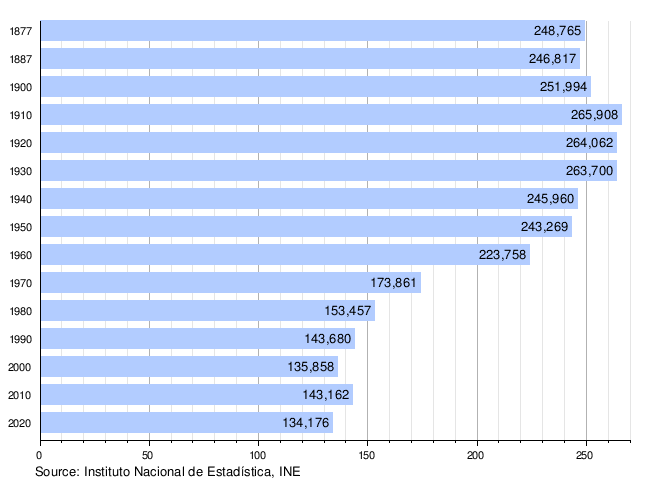Province of Teruel
Teruel Province | |
|---|---|
 The Sierra Carrascosa with the Guerrero Romano rock formation near Bordón | |
|
Ranked 49th | |
| • Density | 9.1/km2 (24/sq mi) |
| Demonym | Turolense |
Teruel (Catalan: Terol [təˈɾɔl]) is a province of Aragon, in the northeast of Spain. The capital is Teruel.
It is bordered by the provinces of
The main language throughout the province is Spanish (with official status), although Catalan is spoken in a northeastern area bordering Catalonia.
Geography
This province is located in the
Depopulation and neglect
Most of the Teruel Province has undergone massive depopulation since the middle of the 20th century. This situation is shared with other areas in Spain, particularly with those near the
The exodus from the rural mountain areas in Teruel rose after
As a consequence there are many ghost towns in different parts of the province.[1]
A great number of surviving towns in Teruel province have only a residual population, reviving somewhat during the summer when a few city-dwellers spend their holidays there. Other causes of the strong emigration have been the low productivity of traditional agricultural practices, like sheep and goat farming, the closing of mines, like the large Sierra Menera mine near Ojos Negros,[2] as well as the lifestyle changes that swept over rural Spain during the second half of the 20th century.[3]
The "Teruel Exists" (Spanish: Teruel existe) movement began at the turn of the 21st century. It is a platform of provincial authorities, institutions and sympathizers seeking to reverse the long-standing neglect of this province.[4]
Population development
The historical population is given in the following chart:

Comarcas
The following Comarcas of Aragon are located in Teruel Province:
- Bajo Martín
- Jiloca
- Cuencas Mineras
- Andorra-Sierra de Arcos
- Bajo Aragón
- Comunidad de Teruel
- Maestrazgo
- Sierra de Albarracín Comarca
- Gúdar-Javalambre
- Matarraña
Notable people
- Luis Buñuel, film director from Calanda
- Gaspar Sanz, music composer from Calanda
- Antón García Abril, music composer
- Pablo Serrano, sculptor from Crivillén
- Luis Milla, retired footballer who played for CD Teruel, FC Barcelona and R. Madrid
- David Civera, light music singer
- Federico Jiménez Losantos, author, journalist and radio host
- Manuel Pizarro Moreno, businessman, politician and jurist
See also
- La Vaquilla del Ángel
- List of Aragonese comarcas
- List of municipalities in Teruel
- Lower Aragon
- Sistema Ibérico
- MotorLand Aragón
Notes and references
- ^ Pueblos deshabitados – Collado de la Grulla (Teruel)
- ^ La Compañía Minera de Sierra Menera. Breve historia Archived 23 March 2012 at the Wayback Machine
- ^ Despoblación en Aragon Archived 23 August 2012 at the Wayback Machine
- ^ Teruel existe
External links
- Teruel.org
- Teruel Info. – Caciquismo & desarrollismo – N.B. This text-only website is in Japanese. Content not clear.
- Teruel Digital
- Directory in dmoz.org
- Fundación Amantes de Teruel
- Estado de los embalses de Teruel
- Teruel.com – Tourism
- Deteruel.com — Comunidad virtual de Teruel
- El número de ancianos españoles aumenta un 20% en 13 años
